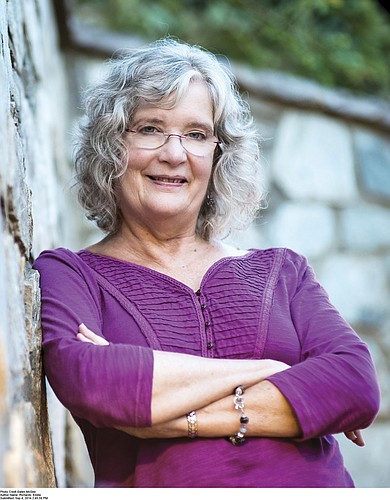- May 10, 2025
-
-
Loading

Loading

Emilie Richards has written (and successfully published) more than 70 novels. All without taking a literature class after high school.
“I did very little creative writing until I was an adult,” the Osprey resident says. “I tested out of English classes in college and did just one creative writing elective for fun. I was immediately entranced.”
As an American studies major at Florida State University who later earned her master’s degree in family development at Virginia Tech, Richards says writing wasn’t part of the plan. But several years out of school, she was in between jobs and living with her family in New Orleans. Seeking a new hobby to take up while raising her youngest child, Brendan, she thought back to that fateful FSU elective and became a writer.
“I was terrified, but it was also the most wonderful thing in the world to sit at a computer and let my imagination go wild,” she says. “I really didn’t know what I was doing — I had no clue — so I went to the library and read the whole shelf of self-publishing books.”
She published her first book, a romance novel called “Brendan’s Song,” in 1985 after two-and-a-half years of work. It was a hit, and she hasn’t taken her fingers off the keyboard since.
Richards had already found success in the mental health and family services sectors before she wrote “Brendan’s Song,” but she quickly discovered a new exciting career as an author.
“Every little bit of writing I got to do I just loved,” she says. “I would have been delighted to know I was going to become a professional.”
She most enjoyed the flexible hours that made it possible to be constantly present in her children’s lives — stealing writing time in between “baking cupcakes and checking homework,” as she says in her author biography.
Soon her writing career progressed, and Richards realized how swiftly readers’ — and publishers’ — tastes change. When she first got into the field, contemporary romance was the hot genre, but suddenly publishers started redirecting their interests to other mainstream women’s fiction novels. Richards had to adapt or get out.
In the early 1990s, she moved out of romance and into books about family relationships. Her background as a mental health counselor and later a Head Start coordinator left her with a fascination with family interaction and secrets, and those subjects quickly consumed her books. She wrote several family sagas before feedback alerted her that readers wanted shorter, broader pieces, so she switched to more problem-oriented women’s fiction.
Ever the chameleon, Richards soon changed colors again and began what became her “Ministry is Murder” mystery series.
Her newest book, “A Family of Strangers,” is much more suspenseful than other Richards novels of late. (It also takes place in the fictional coastal town of Seabank, a place not too different than Sarasota.) The plot was birthed from a news story she first heard in 2002 about a young married couple who murdered another couple seemingly for fun.
“It kept in my head — someone has all that going for them and lapses that way and changes their life in such an evil way,” Richards says. “I thought of what it would be like to be in a family with someone who does something like that — looking up to a sister who always seemed perfect but wasn’t.”
Like all her books, the first step was research and mapping out the plot. The internet has made this part significantly easier and cuts out all the time she used to spend scouring libraries for basic facts.
“Now it takes me two seconds to find the answer online,” she says with a chuckle.
Richards notes that suspense novels call for a much more careful attention to detail because of all of the twists and turns and key character developments. For “A Family of Strangers,” she spent a day at an Orlando dog-training facility to get a few niche questions answered.
Asking how often she gets distracted throughout the writing process also caused a laugh.
“I’m focused when I’m at my desk, but sometimes I’ll sit watching TV and think, ‘Oh, I should do something like that,’” she says. “For nine months you’re totally wrapped up in that story. … It’s hard to just drop it at the end of the day. That’s why it’s good for artists to hang their work in a gallery [where] they can’t get to it anymore. For me, once it’s in production, that’s it.”
Many of her readers ask if Richards’ books are autobiographical, and they aren’t minus a few commonalities with her characters. Instead, these stories are her fantasies, she says, and putting them to paper and having them read by people near and far is the best job she could ever ask for.